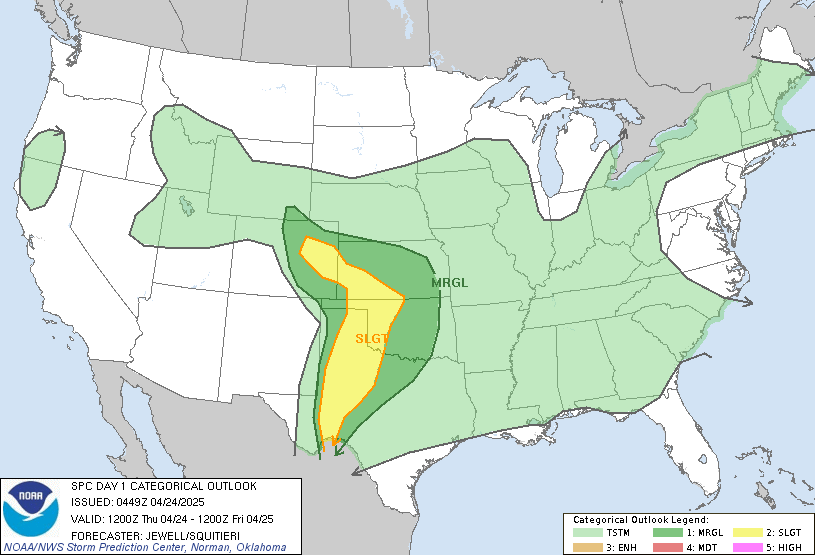LIVE MAP (ABOVE) ... SPC 1200Z Day 1 Outlook
Day 1 Convective Outlook
NWS Storm Prediction Center Norman OK
1258 AM CDT Mon May 19 2025
Valid 191200Z - 201200Z
...THERE IS A MODERATE RISK OF SEVERE THUNDERSTORMS ACROSS MUCH OF
CENTRAL AND EASTERN OKLAHOMA INTO THE WESTERN OZARKS...
...THERE IS A SLIGHT RISK OF SEVERE THUNDERSTORMS ACROSS PARTS OF
THE SOUTHERN APPALACHIANS...
...SUMMARY...
Significant severe weather is likely from the central/southern
Plains into the the Ozarks today into tonight. All severe weather
hazards are expected, to include tornadoes (some potentially strong
to intense), very large hail, and severe winds.
...Synopsis...
A highly amplified large-scale trough will move gradually eastward
from the Rockies across the Plains through the period. Within the
base of the trough, an embedded shortwave trough and accompanying
70-kt midlevel speed maximum will overspread the southern and
central Plains. In response, a surface cyclone will deepen over
north-central Oklahoma, while a focused low-level jet gradually
strengthens along/east of a dryline extending southward from the
surface cyclone (west of the I-35 corridor).
...Central/Southern Plains into the Mid Mississippi Valley...
Along/east of the dryline, rich boundary-layer moisture (lower 70s
dewpoints) beneath steep midlevel lapse rates accompanying an EML
will contribute to strong/extreme surface-based buoyancy -- aided by
diurnal heating within cloud breaks. Ascent along the dryline,
augmented by the increasing midlevel ascent, will support convective
development during the early afternoon west of the I-35 corridor.
Storms should quickly intensify into a mix of supercells (from far
southern KS southward) and organized clusters/line segments (further
north) as they encounter the extreme instability and 50+ kt of
effective shear. All severe hazards will be possible with this
activity, including very large hail, damaging winds, and tornadoes
(some possibly strong to intense).
Similarly, warm-sector storm development is expected farther east
across eastern Oklahoma and vicinity, given weak inhibition, rich
boundary-layer moisture, and the aforementioned large-scale ascent.
Despite the potential for scattered to numerous storms, the high-end
environment will support long-track, semi-discrete supercells and
organized clusters capable of all severe hazards. While overall
convective evolution is somewhat uncertain, a 50-kt low-level jet
and related large clockwise-curved hodographs (200-300+ 0-1km SRH)
should support an increasing risk of strong/intense tornadoes during
the late afternoon into the evening hours. Storms will generally
spread/develop east-northeastward into the Mid-Mississippi Valley
into the overnight hours, and gradual upscale growth into several
organized clusters is possible -- with a continued all-hazards
severe risk.
...Southern Appalachians...
Along the northern periphery of shortwave ridging over the
Southeast, a midlevel jet streak will cross the southern
Appalachians during the afternoon. Here, an influx of steep midlevel
lapse rates atop rich boundary-layer moisture will yield strong
surface-based instability along/south of a warm front draped across
the region. Scattered thunderstorms will spread east-southeastward
along/south of the front from TN into the southern Appalachians,
where the favorable buoyancy and around 40-50 kt of effective shear
will promote organization into clusters and a couple splitting
supercell structures. Damaging winds and large hail will be possible
with the strongest storms.
..Weinman/Darrow.. 05/19/2025
Read more CHECK UPDATE ZOOM GRAPHIC
http://dlvr.it/TKrmdX
Windy.com Temps | Gusts | WU KORD KPWK |
CLICK for this month's BIG night sky ... | RADAR FULL MAP SCREEN |
|---|
MOBILE DEVICE? Turn sideways. Weather conditions directly above are near Lakefront. Top tabs refer to O'Hare (official).
Archives for the SPC Convective Outlook are updated daily (approximately) with a live map at the beginning of each article. Follow the link at the end of the article to check for current updates on the NOAA/NWS Storm Prediction Center website. Also, see Archives for Chicago's hourly weather data on CARDINAL NEWS Magazine.
CONVECTIVE | TORNADO | WIND | HAIL
O'Hare International Airport KORD
(Arlington Heights South)
Chicago Executive Airport KPWK
(Arlington Heights North)
Monday, May 19, 2025
SPC May 19, 2025 0600 UTC Day 1 Convective Outlook
SUNRISE AND SUNSET TIMES IN UTC (if you're not logged in to Google)
CHICAGO UTC-6 during CST (Central Standard Time, e.g., winter)
CHICAGO UTC-5 during CDT (Daylight Savings Time, e.g., summer)
CHICAGO UTC-6 during CST (Central Standard Time, e.g., winter)
CHICAGO UTC-5 during CDT (Daylight Savings Time, e.g., summer)





















